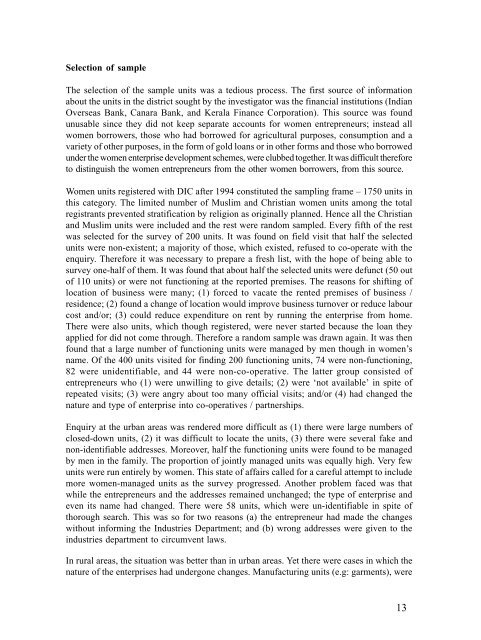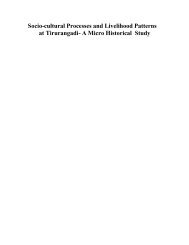Constraints on Women Entrepreneurship Development in Kerala: An ...
Constraints on Women Entrepreneurship Development in Kerala: An ...
Constraints on Women Entrepreneurship Development in Kerala: An ...
You also want an ePaper? Increase the reach of your titles
YUMPU automatically turns print PDFs into web optimized ePapers that Google loves.
Selecti<strong>on</strong> of sample<br />
The selecti<strong>on</strong> of the sample units was a tedious process. The first source of <strong>in</strong>formati<strong>on</strong><br />
about the units <strong>in</strong> the district sought by the <strong>in</strong>vestigator was the f<strong>in</strong>ancial <strong>in</strong>stituti<strong>on</strong>s (Indian<br />
Overseas Bank, Canara Bank, and <strong>Kerala</strong> F<strong>in</strong>ance Corporati<strong>on</strong>). This source was found<br />
unusable s<strong>in</strong>ce they did not keep separate accounts for women entrepreneurs; <strong>in</strong>stead all<br />
women borrowers, those who had borrowed for agricultural purposes, c<strong>on</strong>sumpti<strong>on</strong> and a<br />
variety of other purposes, <strong>in</strong> the form of gold loans or <strong>in</strong> other forms and those who borrowed<br />
under the women enterprise development schemes, were clubbed together. It was difficult therefore<br />
to dist<strong>in</strong>guish the women entrepreneurs from the other women borrowers, from this source.<br />
<strong>Women</strong> units registered with DIC after 1994 c<strong>on</strong>stituted the sampl<strong>in</strong>g frame – 1750 units <strong>in</strong><br />
this category. The limited number of Muslim and Christian women units am<strong>on</strong>g the total<br />
registrants prevented stratificati<strong>on</strong> by religi<strong>on</strong> as orig<strong>in</strong>ally planned. Hence all the Christian<br />
and Muslim units were <strong>in</strong>cluded and the rest were random sampled. Every fifth of the rest<br />
was selected for the survey of 200 units. It was found <strong>on</strong> field visit that half the selected<br />
units were n<strong>on</strong>-existent; a majority of those, which existed, refused to co-operate with the<br />
enquiry. Therefore it was necessary to prepare a fresh list, with the hope of be<strong>in</strong>g able to<br />
survey <strong>on</strong>e-half of them. It was found that about half the selected units were defunct (50 out<br />
of 110 units) or were not functi<strong>on</strong><strong>in</strong>g at the reported premises. The reas<strong>on</strong>s for shift<strong>in</strong>g of<br />
locati<strong>on</strong> of bus<strong>in</strong>ess were many; (1) forced to vacate the rented premises of bus<strong>in</strong>ess /<br />
residence; (2) found a change of locati<strong>on</strong> would improve bus<strong>in</strong>ess turnover or reduce labour<br />
cost and/or; (3) could reduce expenditure <strong>on</strong> rent by runn<strong>in</strong>g the enterprise from home.<br />
There were also units, which though registered, were never started because the loan they<br />
applied for did not come through. Therefore a random sample was drawn aga<strong>in</strong>. It was then<br />
found that a large number of functi<strong>on</strong><strong>in</strong>g units were managed by men though <strong>in</strong> women’s<br />
name. Of the 400 units visited for f<strong>in</strong>d<strong>in</strong>g 200 functi<strong>on</strong><strong>in</strong>g units, 74 were n<strong>on</strong>-functi<strong>on</strong><strong>in</strong>g,<br />
82 were unidentifiable, and 44 were n<strong>on</strong>-co-operative. The latter group c<strong>on</strong>sisted of<br />
entrepreneurs who (1) were unwill<strong>in</strong>g to give details; (2) were ‘not available’ <strong>in</strong> spite of<br />
repeated visits; (3) were angry about too many official visits; and/or (4) had changed the<br />
nature and type of enterprise <strong>in</strong>to co-operatives / partnerships.<br />
Enquiry at the urban areas was rendered more difficult as (1) there were large numbers of<br />
closed-down units, (2) it was difficult to locate the units, (3) there were several fake and<br />
n<strong>on</strong>-identifiable addresses. Moreover, half the functi<strong>on</strong><strong>in</strong>g units were found to be managed<br />
by men <strong>in</strong> the family. The proporti<strong>on</strong> of jo<strong>in</strong>tly managed units was equally high. Very few<br />
units were run entirely by women. This state of affairs called for a careful attempt to <strong>in</strong>clude<br />
more women-managed units as the survey progressed. <strong>An</strong>other problem faced was that<br />
while the entrepreneurs and the addresses rema<strong>in</strong>ed unchanged; the type of enterprise and<br />
even its name had changed. There were 58 units, which were un-identifiable <strong>in</strong> spite of<br />
thorough search. This was so for two reas<strong>on</strong>s (a) the entrepreneur had made the changes<br />
without <strong>in</strong>form<strong>in</strong>g the Industries Department; and (b) wr<strong>on</strong>g addresses were given to the<br />
<strong>in</strong>dustries department to circumvent laws.<br />
In rural areas, the situati<strong>on</strong> was better than <strong>in</strong> urban areas. Yet there were cases <strong>in</strong> which the<br />
nature of the enterprises had underg<strong>on</strong>e changes. Manufactur<strong>in</strong>g units (e.g: garments), were<br />
13










